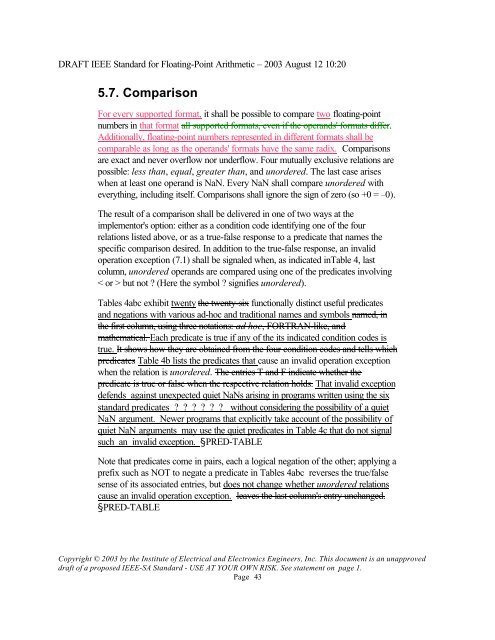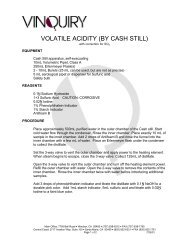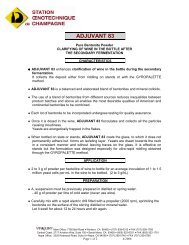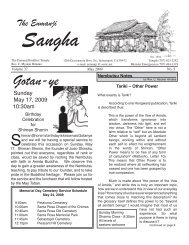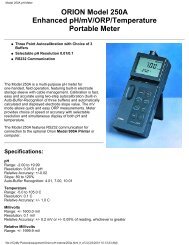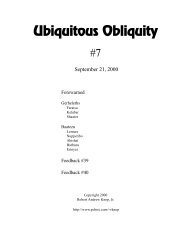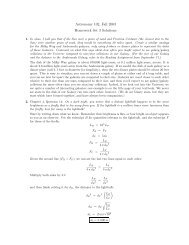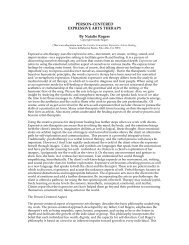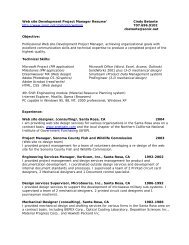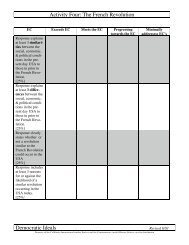DRAFT IEEE Standard for Binary Floating-Point Arithmetic - Sonic.net
DRAFT IEEE Standard for Binary Floating-Point Arithmetic - Sonic.net
DRAFT IEEE Standard for Binary Floating-Point Arithmetic - Sonic.net
Create successful ePaper yourself
Turn your PDF publications into a flip-book with our unique Google optimized e-Paper software.
<strong>DRAFT</strong> <strong>IEEE</strong> <strong>Standard</strong> <strong>for</strong> <strong>Floating</strong>-<strong>Point</strong> <strong>Arithmetic</strong> – 2003 August 12 10:20<br />
5.7. Comparison<br />
For every supported <strong>for</strong>mat, it shall be possible to compare two floating-point<br />
numbers in that <strong>for</strong>mat all supported <strong>for</strong>mats, even if the operands' <strong>for</strong>mats differ.<br />
Additionally, floating-point numbers represented in different <strong>for</strong>mats shall be<br />
comparable as long as the operands' <strong>for</strong>mats have the same radix. Comparisons<br />
are exact and never overflow nor underflow. Four mutually exclusive relations are<br />
possible: less than, equal, greater than, and unordered. The last case arises<br />
when at least one operand is NaN. Every NaN shall compare unordered with<br />
everything, including itself. Comparisons shall ignore the sign of zero (so +0 = –0).<br />
The result of a comparison shall be delivered in one of two ways at the<br />
implementor's option: either as a condition code identifying one of the four<br />
relations listed above, or as a true-false response to a predicate that names the<br />
specific comparison desired. In addition to the true-false response, an invalid<br />
operation exception (7.1) shall be signaled when, as indicated inTable 4, last<br />
column, unordered operands are compared using one of the predicates involving<br />
< or > but not ? (Here the symbol ? signifies unordered).<br />
Tables 4abc exhibit twenty the twenty-six functionally distinct useful predicates<br />
and negations with various ad-hoc and traditional names and symbols named, in<br />
the first column, using three notations: ad hoc, FORTRAN-like, and<br />
mathematical. Each predicate is true if any of the its indicated condition codes is<br />
true. It shows how they are obtained from the four condition codes and tells which<br />
predicates Table 4b lists the predicates that cause an invalid operation exception<br />
when the relation is unordered. The entries T and F indicate whether the<br />
predicate is true or false when the respective relation holds. That invalid exception<br />
defends against unexpected quiet NaNs arising in programs written using the six<br />
standard predicates ? ? ? ? ? ? without considering the possibility of a quiet<br />
NaN argument. Newer programs that explicitly take account of the possibility of<br />
quiet NaN arguments may use the quiet predicates in Table 4c that do not signal<br />
such an invalid exception. §PRED-TABLE<br />
Note that predicates come in pairs, each a logical negation of the other; applying a<br />
prefix such as NOT to negate a predicate in Tables 4abc reverses the true/false<br />
sense of its associated entries, but does not change whether unordered relations<br />
cause an invalid operation exception. leaves the last column's entry unchanged.<br />
§PRED-TABLE<br />
Copyright © 2003 by the Institute of Electrical and Electronics Engineers, Inc. This document is an unapproved<br />
draft of a proposed <strong>IEEE</strong>-SA <strong>Standard</strong> - USE AT YOUR OWN RISK. See statement on page 1.<br />
Page 43


